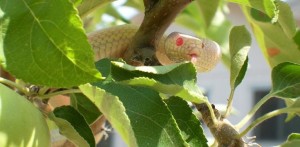
Many lizard and snake species populations are crashing at Organ Pipe National Monument, researchers have found.
The declines match a recently discovered global decline in snakes and lizards that scientists say could be linked to climate change.
University of Arizona research scientist Phil Rosen said his analysis found 50 percent declines in eight snake species and a half-dozen lizard species that he has trapped for 22 years at Organ Pipe Monument, about 140 miles southwest of Tucson.
He thinks climate could be a factor, because the lizard and snake species whose populations dropped are far more sensitive to heat and drought, respectively, than those whose populations didn’t drop there, Rosen said. The National Park Service financed and conducted most of the monitoring for the research, which is ongoing.
“I think this points to a potentially quite marked and severe effect of climate across the board,” Rosen said. “I am not going to claim to be certain about a thing like that. I am just saying that these data are consistent with the trend toward impacts of hotter, drier weather. I think it is a brick in the wall – a pretty solid brick.”
Ecologically, the effect could be significant, researchers say. Snakes are heavy eaters of rodents. Lizards eat flies, ants and grasshoppers, and are prey for mammals and birds, said Rosen and other researchers.
Rodents are carriers of disease such as plague and hantavirus, Rosen said. “That is what happens when ecosystems go out of whack. You get huge amounts of things and they tend to get sick and carry diseases,” he said. While rodents carrying such diseases aren’t common here, that’s partly because they’re held in check by predators, he said.
Globally, researchers are concerned that if snakes decline and rodents increase, the rodents could hurt production of food crops.
Specifically, Rosen and two researchers working at Organ Pipe found that:
• Five snake species that fared well at Organ Pipe are adapted to drier weather because they live on the monument’s western side, where rainfall is lower and where the desert is dominated by dryland survivors such as creosote and bursage. The eight declining snake species live mainly in the monument’s eastern, wetter section, where the desert is similar to Tucson’s saguaro-palo verde habitat that gets more rain.
• The monument’s six declining lizard species “make a living in the sun,” by being active in the open and shuttling between small patches of shade and the sun. So when the monument’s temperatures rise, the heat affects them more, he said. Six species that didn’t decline live in trees or on the ground at night, and can stay active in hotter temperatures.
The global snake study found that snake declines accelerated from about 1998 to 2002 and never recovered. The same pattern occurred with the Organ Pipe snakes, Rosen said.
Similarly, the global lizard studies have found the sun-dependent lizards were suffering more than those that live in trees, said Don Miles, an Ohio University researcher who worked on the global lizard study.
Rosen said he originally picked Organ Pipe as a research site to try to isolate the effects of climate compared with the effects of urban areas such as sprawl, road-building and road kill. Off and on for a decade, he camped at the monument to carry out his research.
Organ Pipe’s climate has a transition from very dry at its west end to rainfall levels approaching Tucson’s at its east end – 25 miles apart. That makes Organ Pipe’s findings a bellwether of what could happen here someday, Rosen said.
“I doubt that the same pattern has happened in Tucson yet because Tucson’s not as dry as Organ Pipe,” Rosen said. “But as things get hotter and drier, the effects will move across the Tohono O’odham Reservation and toward Tucson.”
Also, if it turns out that climate change is as important to reptiles as research suggests, it would add a new impact on biological diversity besides development, habitat degradation and non-native-species invasions, he said.
“It would mean there is no easy answer for them . . . Keeping all these animals alive in reserves wouldn’t work,” Rosen said. “It undermines the idea of a reserve system as the answer to habitat degradation.”
On StarNet: The critters of Southern Arizona database at azstarnet.com/ critters can help you identify that visitor in your back yard.
Species declining
Snakes declining at Organ Pipe National Monument include:
• Mojave diamondback rattlesnake
• Western diamondback rattlesnake
• Kingsnake
• Gopher snake
Lizards declining at Organ Pipe include:
• Zebra-tailed lizard
• Red-backed whiptail lizard
• Regal horned lizard
Reptile declines elsewhere:
• Snakes. Researchers found that 11 of 17 snake populations studied in Europe, Nigeria and Australia had plummeted between 1998 and 2002 and haven’t recovered. Researchers suspect they had multiple causes with a common factor such as global climate change as their root. (Source: Centre for Ecology and Hydrology in England.)
• Lizards. Researchers found that 12 percent of local populations for 48 lizard species in Mexico have gone extinct since 1975. Researchers predict that by 2080, 20 percent of all lizard species globally will be extinct. A researcher on that study, Don Miles of Ohio University, has found significant declines in ornate tree lizards at Saguaro National Park in the Tucson area since about 2003 and found that local populations of two other lizard species have disappeared in Western Arizona and the Southern California desert.











